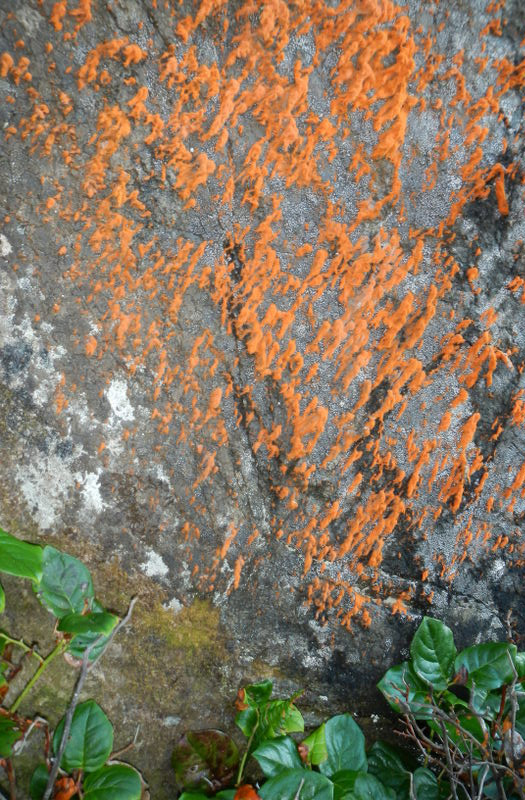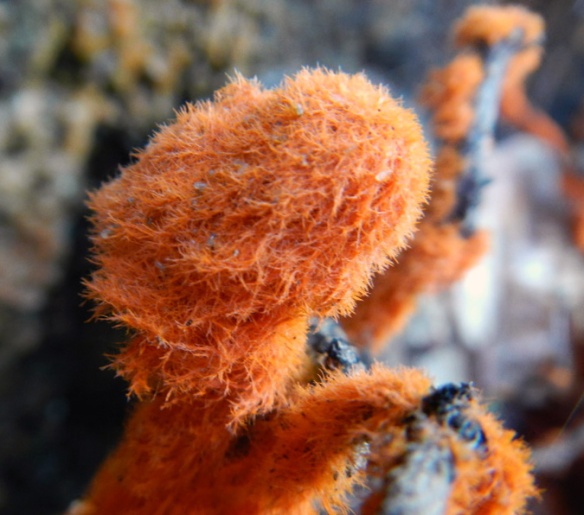While out exploring the coastal forest we came across something that didn’t seem right. It was a fuzzy orange wall.
Seeing as it was growing on rocks, our first assumption was that it was a lichen.
Looking closer, it was softer and more 3D than I would expect for a lichen growing on a rock face. Perhaps it was a fungus instead.

The organism is fuzzy and sticks out from the rock in a way I wouldn’t expect for a lichen on a sheer face Credit: N. Webster
The difference between a lichen and a fungus is a fine one though, as a lichen is not a single organism; it is actually a symbiotic relationship between a fungus and an algae (or cyanobacterium). This is a flexible arrangement, with multiple species of fungi and algae being capable of living in symbiosis. Its a powerful arrangement too, the fungi are hardy and can protect the photosynthetic componant, receiving nutrients in return. Lichen are a fascinating and complex topic that I highly recommend you read up on for yourselves. Learning about lichens was one of those epiphany moments for me, that opened up a whole new realm of possibilities on the complexities of life.
Needless to say I was intrigued. Up close, the ‘lichen’ has a foliose morphology. This is when the lichen is made of branched strands, and looks like hair or a shrub.
I decided to bring some back to take a look at under the microscope. Hyphae – the strands of connected cells in a fungus look like clear tubes. Lichens are more complex under the microscope because you have to add the algae/cyanobacteria component, and usually have little green dots, or filaments inside the fungus. This looked like neither. It had the hyphae like strand structure but with orange droplets filling it up. No green, no complex structure.
As with many more complex topics, googling fuzzy orange lichen/fungus got me no where (as it did for my fuzzy pink barnacle fungus – what is with the fuzzy theme?). This time I decided I knew enough to get a fungus/lichen key from the library and sort it out. I picked The lichens of British Columbia: Illustrated Keys. Part 2 – Fruticose species. It turns out this guide is also online (see link)! I went to the key to lichen growth forms and followed along: 1b- never entirely crustose, 2b – cylindrical stalks – hairlike, 3a (here is where it get interesting) “Note: Orange specimens key here regardless of size”. hunh: On to Key A Fruticose Macrolichens.
1a-“Thallus dark over entire surface: blackish, dark greyish, or dark brownish” Nope.
1b;-“Thallus pale, or at least not dark throughout… primary photobiont strictly medium green…”
Now what? There’s no green. In a key, do your best, an almost beats a no, and “not dark throughout” was better than “dark over entire surface”.
19a “Thallus … bright medium orange” YES
20a “Sparsely branched… threadlike… very humid sites” like near the ocean? Yes
→”Trentepohlia [an algae, not handled]”
Mystery solved! Not a lichen after all, and not a fungus, but the other half, an alga! It grows in moist terrestrial environments, and is orange because of all the carotenoid pigments, which blocks out the visibility of any green chlorophyll. For information more indepth than wikipedia, here’s a great link
Afterwards I found this site which would have solved my problem right away – it shows Trentepohlia as something commonly mistaken for a lichen.




